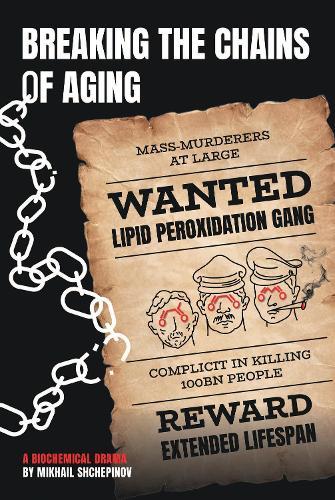Overview
Oxygen fuels our bodies with life-giving energy — but at a hidden cost: over time, it also slowly degrades the very systems it powers. Breathing oxygen generates a energy by burning our food but at the same time oxygen relentlessly wears out all parts of our biochemical machinery. Breaking the chains of aging explains how the most pernicious type of biological oxidative damage is lipid peroxidation (LPO), as it is the only example of the non-enzymatic chain reaction. The exponential nature of LPO, which once ignited generates multiple damage, makes antioxidants inefficient. The body does not invest enough into clean up processes, so the waste products of LPO accumulate with time, accelerating the aging process. Lipid peroxidation affects multiple organs and cellular structures — including the brain, eyes, skin, and mitochondria — as well as key biological processes like sleep regulation, pain perception, inflammation, and aging. Drawing on 3 decades of experience in academia and commerce Mikhail Shchepinov provides an overview of the underlying biochemical processes, and describes a novel approach to mitigating the LPO-inflicted damage. Breaking the chains of aging will be of interest to all those with an interest in the process of aging.
Full Product Details
Author: Mikhail Shchepinov
Publisher: The Cloister House Press
Imprint: The Cloister House Press
Dimensions:
Width: 15.60cm
, Height: 1.60cm
, Length: 23.40cm
Weight: 0.432kg
ISBN: 9781913460976
ISBN 10: 1913460975
Pages: 306
Publication Date: 20 September 2025
Audience:
College/higher education
,
General/trade
,
Postgraduate, Research & Scholarly
,
General
Format: Paperback
Publisher's Status: Active
Availability: Available To Order

We have confirmation that this item is in stock with the supplier. It will be ordered in for you and dispatched immediately.
Reviews
Shchepinov is a true biomedical ground breaker. His insight, now dating back over 20 years, that the isotope effect might have medical utility was so outlandish that even I, one of the field's prouder heretics, was initially inclined to dismiss it. How glad I am that I put my doubts aside and, in small ways, helped his vision to become the proven concept that it is today. In this book, Shchepinov presents the idea and its development in a form that should be easily digestible by the layperson. Its time has come! -Aubrey D.N.J. de Grey, British biomedical gerontologist, founder of SENS and LEV foundations https://en.wikipedia.org/wiki/Aubrey_de_Grey Lipid peroxidation is a fundamental mechanism of oxidative damage that has been studied for over 100 years, by such pioneers as Trevor Slater, Hermann Es terbauer, Al Tappel, John Gutteridge, Jason M01rnw, Ned Porter and many others. The recent discovery of ferroptosis has re-awakened interest in iron, lipid peroxidation and glutathione peroxidases although old concepts are frequently presented as novel in the ferroptosis literature. In this amusing, provocative and sometimes iconoclastic book, Misha Shchepinov explores the role of fatty acids, lipid peroxidation and iron in human health and disease, and presents an argument that deuterated fatty acids may be important therapeutic agents, especially for neurodegenerative diseases. It is a good read, I recommend it. - Barry Halliwell, British biochemist, author of the landmark textbook, Free Radicals in Biology and Medicine https://en.wikipedia.org/wiki/Barry_Halliwell Food for thought: suppose there were a food supplement that actually protects brain health? Wouldn't taking it be irresistible? This book describes the biology and chemistry that plays a role in many brain diseases. During human evolution we became dependent on long-chain fatty acids for proper function of nerve cell membranes. Oxidative damage to these molecules is rampant as we age and matters a great deal now that the average span approaches 80. The author of this book Mikhail Shchepinov is the inventor of a supplement, deuterated long chain fatty acids, which shows great promise in slowing the damage and may be protective in many age-related diseases. The book is a charming mixture of science and the authors personal recollections and iconoclastic ideas. - Charles R. Cantor, American biophysicist, molecular geneticist, NAS member since 1988 https://en.wikipedia.org/wiki/Charles_Cantor https://embryo.asu.edu/pages/charles-robert-cantor-1942 With sharp wit and keen insight, my friend Misha takes us on an extraordinary tour through the biochemistry of aging and neurodegeneration. Oxygen that double-edged sword driving the fire of life-sustains our metabolism while simultaneously escaping to wreak havoc on our most vulnerable biomolecules: the polyunsaturated lipids. Misha's elegant solution to reinforce these molecules of life offers a brilliant approach to taming one of aging's most insidious culprits, potentially unlocking new pathways in our struggle against neurodegeneration. - J. Thomas Brenna, American analytical chemist and nutrition scientist specializing in lipids, particularly in infant development and human evolution. https://en.wikipedia.org/wiki/Tom_Brenna
Author Information
Mikhail S. Shchepinov has a PhD degree in bioorganic chemistry. He worked in academia and biotech in Oxford, UK and San Diego, USA, and is currently affiliated with several universities. His area of interest is the chemistry of aging and mitigation of age-related diseases.



